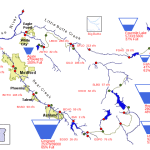Hypothesis: by Julie Bonney Professional Lab Technician
E. coli (Escherichia coli)
Piping the Ashland Canal will not lead to lowered E. coli counts. Proper cleaning and maintenance will lead to lower E. coli levels within Ashland’s TID canal.
Background:
Power washing and vacuuming up the debris and sediment was part of the preparatory work that Robinson Concrete (the company that did repair work on 400 feet of canal in April 2019) did prior to applying Fiber Reinforced Concrete by shotcrete application to repair this section of canal. The vacuuming was by explicit instruction of the City.
The City and County Work Release crews that come through prior to the beginning of the irrigation season only use shovels, rakes, wheelbarrows and leaf blowers to clean the ditch removing the large debris from the canal. They do not wash it, thereby leaving fine particulate material in the bottom of the canal. The City also does not clean the inside of the currently piped sections, so there is undoubtedly some sediment that has accumulated on the bottom of these as well. City crews cleaned the canal this past spring on March 25th, 26th, 28th and 29th, 2019. Studies have shown that E. coli has natural reservoirs in soil, sand, algae and plants seemingly in the absence of fecal material. Because of this natural reservoir, there is a potential for the debris left on the canal bank and the sediment that is left at the bottom of the canal and piped sections to contaminate the water.
It is of concern to the City that we keep storm water run-off out of the canal, but as noted in the Ashland Creek Bacterial Study, it hardly rains in Ashland during the summer. The TID is not the only source of storm run-off. Storm drains also add additional E. coli to Ashland Creek. There are 19 storm drains that empty into Ashland creek above the wading area in Lithia Park according to city data. Rogue Valley Council of Governments is currently monitoring the storm drains that empty into Bear Creek to better understand storm drain influence on water quality.
According to the preliminary engineering report by Adkins Engineering, if the piping project were completed, there is a plan to place a “traveling bar screen” at the new inlet. This screen will filter out leaves, sticks and algae, but will not take care of the fine sediment that will continue to come down the canal. Placing a screen fine enough to keep sediment out would completely block the flow of water. As the sediment accumulates in bottom of the pipe, this will become a reservoir for E. coli causing levels to increase again.
Facts about E. coli
General
- Found in the gastrointestinal tract of warm blooded animals, birds, and uncommonly in fish frogs and reptiles.
- Can persist and even thrive in soil, sand, algae and plants (natural environments) in the absence of fecal material.
- Grows best at 37 C° (98.6 F°), but can survive a wide range of temperatures including cold Michigan winters.
- Water quality testing for E. coli only tests for “generic” E. coli
- The TID and Ashland Creek are both conveyances for all kinds of E. coli
- The majority of E. coli 0157infections, a known pathogen, come from consuming contaminated food
From Bear Creek Watershed TMDL-ODEQ Study (July 2007)
- “Fecal indicator bacteria can adhere to suspended particles in water which then settle causing an accumulation of bacteria in the bottom sediment. Concentrations in the sediment can range from 10 to 100 times greater than in the overlying water. Re-suspension of bottom sediment has been shown to increase fecal indicator bacteria concentrations in the water column.” (pg. 6) There is sediment in the bottom of the canal and in the piped sections the Ashland section of TID which could harbor E. coli.
From Ashland Creek Bacterial Study (2011)
- E. coli levels prior to entering currently piped sections show increased counts upon exiting; therefore, if the canal is piped, E. coli addition will not be eliminated. 2010 data: 143.6 prior to entering the piped section at Herbert Street and 163.7 at the TID outfall This area is also a “No Public Access” area on the Ashland Canal trail easements so domestic animal wastes are at a minimum and may not be a large contributing factor.
From a University of Arizona Study (2015):
- “Canal maintenance, involving mechanical removal of sediments and algal growth from canal basins, is necessary for sustaining the viability of the irrigation water delivery system in the Imperial Valley of California”, and “Irrigation district guidelines may consider 1) disposing of the ‘first flush’ of canal water following maintenance into nearby open areas, rather than sending poor-quality water into the irrigation canal system; 2) collect sediments and algae deposited on the canal banks and transport to a secondary location to prevent precipitation runoff and re-introduction of bacteria-laden sediments to canals”.
From the City Study Session 8-5-2019:
- The city acknowledges that water from the TID is very turbid and will need to be run through a very fine screen in order to remove sediment at the water treatment plant.
DEQ water standards
For Freshwater Contact Recreation ORS 340-041-009 (1)(a)(A)(B):
- 90-day geometric mean of 126 E. coli/100ml using a minimum of 5 samples
- No single sample may exceed 406 E. coli/100ml
- Intention is to maintain a risk of G.I. illness at fewer than 8 cases per 1,000 swimmers at freshwater beaches based on exposure to point-source*, untreated human wastewater discharge or spill.
*Point Sources include: Waste Water Treatment Facilities, Landfills, Onsite Sewage Systems, Stormwater Discharges and Confined Animal Feeding Operations.
For Animal Waste ORS 340-041-0009 (4):
- Animal Waste: Runoff contaminated with domesticated animal wastes must be minimized and treated to the maximum extent practicable before it is allowed to enter waters of the State.
From Parks and Rec
- Bacterial counts on samples taken June 26, 2019 showed elevated levels of E. coli at the swim reservoir and acceptable levels at the wading area. The TID does not influence E. coli levels at the swim reservoir.
Problems with 2011 (data collected during 2010) Ashland Creek Bacterial Study:
- Sample size from site to site is inconsistent.
- Direct sampling of TID outfall, but not of Nutley Storm Drain. This is an issue because we don’t know the level of E. coli contained within any storm water runoff and storm water is known to have higher E. coli levels. There is an increase in E. coli levels downstream of the Nutley storm drain, but we don’t know what the storm run off might be contributing because we don’t know the actual level of E. coli in that water.
- No correlation done between wading area closure and E. coli numbers at TID outfall, so we don’t know how the E. coli levels are influencing any closures at the wading area, if at all.
- E. coli results used by City of Ashland included samples taken during rain events. “The data are somewhat biased because “we purposefully collected samples whenever it rained in order to study potential effects of rain on E. coli levels. It rarely rains in Ashland during the summer…It was noted that E. coli levels were higher during summer rain storms”.
- E. coli counts continue to increase downstream of the TID outfall even though the TID has been shut off (October) indicating there is another source of bacteria input., most likely storm drains (see table below).
Geometric Mean E. coli MPN/100ml during “no rain” days at Ashland Creek Sampling Locations
| Sampling Dates | Site 5 (Above TID Outfall) | TID Outfall (This sample is not from the creek) | Site 3 (Below TID Outfall) | Site 2 (Above Nutley Storm Drain) | Site 1 (Below Nutley Storm Drain) |
| 6/10 – 10/13 | 17.9 | 148.6 | 45.3 | 51.2 | 57.1 |
| 10/14 – 10/30 | 17.8 | Off | 17.8 | 35.3 | 34.9 |
- There is more current data on E. coli counts (2018) which show a decrease of E. coli at the TID outfall, however sample size was smaller and it is unknown if the collections dates included any rain events. 2010 data: 163 MPN E. coli/100ml (outside DEQ limits); 2018 data: 78 MPN E. coli/100ml (the 2018 value is within DEQ limits)
- The source for E. coli was not determined and it was recommended that further study be done, but a thorough study has yet to be done.
General Flaws of E. coli Monitoring:
- Testing does not include identification of pathogenic organisms such as Giardia, Cryptosporidium or Salmonella.
- High E. coli counts may not indicate the presence of pathogenic organisms mentioned above.
- E. coli counts within parameters may not indicate the presence of pathogenic organisms mentioned above.
- E. coli counts can vary depending upon the time of day and morning samples have typically higher counts than afternoon samples
- E. coli counts can vary depending upon the depth of the water. Shallow water typically has higher counts than deeper water
- Variation can also occur from day to day
- E. coli counts are likely to increase following a rain event
- E. coli counts can vary along a shoreline often just inches apart
- Test results do not indicate “real time” counts because incubation time for the testing is 24 hours
Conclusion:
E. coli is of concern to everyone. As indicated in the Ashland Creek Bacterial Study (2011), the source of the E. coli is unknown. “Due to the numerous potential inputs, determining specific sources of high bacteria levels is complicated. Extensive study of the creek is required, including influences of weather and seasons, to determine accurate estimates of means and variability of water quality parameter readings. It is imperative to understand how recreational use, irrigation, and wild and domestic animals influence water quality before solutions to reduce bacteria problems can be addressed.“ and from Recommendations: “While this study indicates that the TID is a conveyance for bacteria, the source of the bacteria remains unknown. Further study is warranted …” Given the information that has been shared, E. coli levels are not a valid reason to pipe the canal. The relevance of E. coli to the decision to pipe the canal is questionable and secondary to the logistical difficulties of construction, community pushback and known and unknown costs of the piping project.
To mitigate the contribution of E. coli to Ashland Creek, the City of Ashland should instead take a look at their current cleaning and maintenance of the canal and make necessary changes to include removal of all debris and sediment that accumulates in the canal to a secondary site. They should also work to come up with a plan to reduce the contribution of storm water runoff from the nineteen storm drains that currently drain into Ashland Creek as well as all of the storm drains within the city that “Drains To Streams”.
E. coli counts will be lowered in Ashland’s TID canal if the city’s two miles are properly cleaned and maintained.






